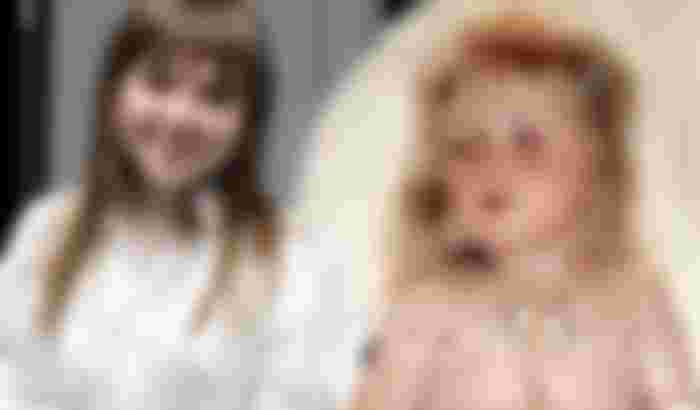With her transplanted heart failing, 12 year old Hannah Clark faced a terrifying choice.
When I was younger, I have heard of heart transplants which is a very expensive procedure. Is it possible? I was wondering how they do it? Unlike today, where technology is common that one can browse the internet and google something which is unknown to him. Before, one only rely on books and media for informations.
Heart transplant is a way to save those with heart conditions who needs it. I was fond of reading, any reading material I can get my hands at, especially when the book is eye catchy. Thus, I came to read about this young girl, a brave caurageous one who faught for her life and beat the odds. (This is a very loooong post, I think it's better I just have to write it all and not cut it into parts. Read and comment out your thoughts ).
The blue light flashing and headligt blazing, an ambulance heads down the highway hugging the fast lane at a speed of more than 160 kph.
Inside were Paul and Elizabeth Clark and their desperately ill daughter Hannah-unaware of the drama swirling around her, are speeding from Wales to the Cardiac unit at Harrfield Hospital, just west of London. Less than two hours ago, Paul answered his mobile phone to hear, "We have a donor. It is match." Two-year-old Hannah is getting a chance at a new lease on life.
Four months after Hannah was born, Elizabeth Clark cradled her tiny blonde daughter and had her visit het pedeatrician. She told her doctor her baby barely sleeps and constantly cries and screams.
The doctor responded that nothing to worry about it as its just a teething problems. The next visit, he told her that its a mild infection. The screaming continued.
A second doctor who examined her, told them that it's nothing serious to which he prescribed vitamin syrups. Yet the parents of this baby knew their was something serious about her.
After a frightening coughing attack,one weekend where Hannah could barely breathe, Paul and Elizabeth hurried to the A&E at Merthyr Tydfil's Prince Charles Hospital. A chest X-ray showed she had dilated cardiomyopathy, a condition that results in an inflamed, enlarged and weakend heart.
Cardiac specialists at Harefield Hospital in Middlesex told the Clarks that Hannah would be lucky to survive another year. They puy her on the waiting list for a heart transplant.
I couldn't imagine the emotions parent/s had to bare and tolerate when they got to learn about their child's condition.
A beeper was securely attached to Paul's belt to alert the family if a heart became available.
Fortunately, less than six months, one did. They rode on an ambulance at high-speed at the Harefield Hospital where Hannah's operation was to be done.
At the hospital, sir Magdi Yacoub, an Egypt-born doctor with other doctors performed the operation on the young patient. A successful five- hour operation.
He told the parents that they decided to leave Hanna's heart in place and attached the donor's heart to it. He told them that he inserted the donor heart into the right side of Hanna's chest and attached it to the original one.
It was a rare heterotopic or "piggyback" transplant procedure, wherein the doctor merged the two hearts' aortas so there would be unified supply of blood to the body and connected the donor's heart to the lungs. While the original heart would still pump some of Hanna's blood, the donor heart would do the bulk of the work.This way, the original heart has a chance to recover.
Growing up this girl, like her rugged forefathers before her, she was a fighter able to cope with any obstacles.
On one of her days in primary, they were asked to climb to the gym ceiling on her P.E class weekly. Hannah, weakend by the powerful anti-rejection drugs she took daily, could barely pull herself a few metres off the ground. Determined as she is, she tried every PE class to hoist herself higher but couldn't. With her determination and high fighting spirit she was hoisting herself to the top of the six-metre rope.
Another challenge to the little girl and her family, she contracted post transplant lymphoprolirative disease (PTLD), a rare cancer that targets the glands, blood and immune system and which might have been triggered by the anti-rejection drugs. Due to this, she was brought back again to Harefield Hospital for a tough regimen of chemotherapy.
She lost lots of hair which came in great clumps after her last chemo session. She then used a wig in school for a few days but later tossed it aside in favor of a cap.
She was bullied by a boy at school after snatching her cap off and called her "cancer head." This girl, instead of crying like a baby turned back and called him "odd socks" while her classmates cheered. "You've got on one green sock and one black sock. Mister odd socks," she added. Wasn't she a tough girl?
By the time she was 11,she had battled PTLD cancer three times. Chemotherapy, coupled with the anti-rejection drugs she took daily to protect her donor heart, wracked her frail body.
On a rainy November morning, the couple with their child, Hannah drove to their cardiologist in Cardiff.
In Dr Obed Onuzo's University Hospital examination room, the cardiologist examined the girl's heart. He applied gel on the girl's chest and taped on electrodes. Wires led to a machine that would give him a cross -section view of the heart. after further examination, Dr Onuzo told the couple there's a problem.
Two days later, they were in London, being briefed at Great Ormond Street Hospital for Children. The news was a bleak.
One of the doctors told them Hannah might not survive to which made Paul rose from his chair and left the room.
He swore himself he'll not gonna lose his child. He told his wife Sir Magdi can do it and he was their only hope.
On that time Sir Magdi had already retired, but the doctors are keen to call him. Surgeon Victor Tang called him and explained the case.
Hanna's heart had deteriorated. Even if her original heart, now stronger, could take over again, to remove the donor heart was unprecedented.
With her donor heart removed, Hannah could be taken off the anti-rejection drugs and the PTLD would be much likely to return. But the odds were grim. It would be the first operation of it's kind in the United Kingdom and could possibly in the world.
Even if the donor heart could be separated, the trauma of the procedure might be too much for a small body wracked by years of chemotherapy and, anti-rejection drugs and severe infections. The couple leave the final decision to Hannah.
On February 20,2006 after 11 am 30 minutes before the operation is due to begin, Paul and Hannah walked hand in hand at the corridor of Great Ormond Street Hospital to the pre-op room. As they enter it, Hannah sees that a green gowned anaesthetist and nurses are waiting for her.
The reality of what's going to happen stops her dead on her track. All the courage she had left her. She squeezed her father's hand and told him she wanted to go home.
Her father bent down and told her in a quite, calm voice that he's not going to push her through. Yet they need to do the right thing. He wiped the tears coming from his child's eyes with his shirtsleeve. He saw the fear on those eyes so he again told her that they will go home if she really doesn't want it.
Moments later when Hannah stepped forward again. Her dad stands beside her as she lies on a white sheeted trolley. She panicked when the anaesthesiologist begun to lower a breathing mask over her face that she blocked it with her hand and reaches to her father.
The loving dad cradled her daughter and asked if she's ready. He slowly moves the mask to her face when she answered yes. The anaesthetist took over and she slipped to unconsciousness.
Elizabeth was seized with fear as her daughter was wheeled away. The thought of the inevitable gripped her that she told her husband she would die too if their child dies.
In the operating room, seven surgeons and staffers clustered around Hanna's small body. The only sound was the repeated squish/thock of a ventilator pushing air into Hanna's lungs. A battery of electronic screens monitored her vital signs.
Sir Magdi Yacoub with his green surgeon's scrubs and 3-power magnifying glasses with a built in light stands on one side of Hannah. Opposite him was Victor Tsang who performed incision into Hanna's chest. He took a jigsaw-like cutter and used it to crack the girl's sternum open. Retractors were inserted and gently open the girl's chest.
Sir Magdi who performed 2500 heart transplants, looked inside. But was astounded as the sight before him was something he had ever seen before.The two hearts have grown together into one reddish-blue mass.
It will test all the skills of this most experienced of surgeons to identify, follow and separate the layers of fused tissues. A wrong move can fatally weaken the remaining heart.
At the waiting room where the couple went, they finished a second cup of coffee. They bought a teddy bear at the hospital gift shop which they intended to put at their daughter's bed recovery unit. To ease the tension, they set their minds to deciding on what to call it. They want it to be the first thing their child sees when she wakes.
The two doctors worked from both sides of the girl's chest. The donor heart, ravaged by rejection was half its original size. They successfully were able to remove it exposing gradually Hanna's original heart. There was no sign of cardiomyopathy that caused it to fail ten years ago. The donor heart worked miraculously, it allowed the original heart to heal by taking most of the work. If Hannah's can't take the full load, he life will be over.

After doing the remaining work which includes repairing the gaping aorta and reconnecting Hanna's heart to her lungs, they turned off the machine and prepared to restart Hanna's heart. They prepared to remove the clamps that will allow blood to fill her heart once more.
Sometimes a stopped heart will restart spontaneously as the blood flows in. More often it needs a shock defibrillator to begin beating again. But, sometimes that, too, can fail.
There was a single pop from the cardiac monitor after sir Magdi inserted the probe of defibrillator into the heart's right ventricle. A 100 volt charge of electricity surges into the into the fist-sized organ.
Success!!!It contracts..
At her bedroom in their house after six days of hospital stay, Hannah leafs though her diary where she confided her thoughts for the past year and begun to tear out pages. One reads, "I hope I will be here for my next birthday." Another, "I don't want to die and never see Mum, Dad, Aimee and Daniel again."
"I don't need them," she answered her mom who saw what she's doing and asked why did she do it. "Im not going anywhere," she added smiling brimming with life.
According to Elizabeth, "Hannah had spurted up about 13cm."
Complications from her anti-rejection drugs have gone and her PTLD cancer has failed to reappear.
I tried googling for Hannah Clark and was amazed to learn about her more. It was a pioneer of its kind, the piggyback transplant.


You can read the latest update here which I was able to look on google, but it was on 2011. https://www.walesonline.co.uk/news/local-news/heart-transplant-girl-hannah-celebrating-1857268



That was an amazing medical feat she pulled out of. Her parents must be so happy about her recovery